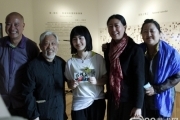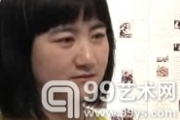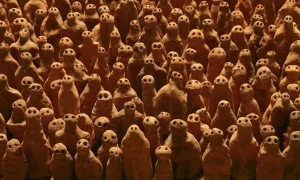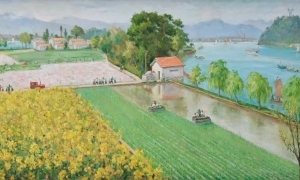
叶甫纳作品——家春秋
"入戏"的砝码:"扮演"白娘子、 苏妲己 、叶倩文、福瑞达……
The model for "getting into the act": "playing" the White Madame, Su Danji, Sally Yeh, Frida Kahlo…
想必,同时期出生的小囡会回想起一连串名词来。叶甫纳的"入戏"能力多少来自童年的那些贫乏记忆,如此共通的记忆样本化地采集了85年左右出生的一代数目可观的城市独生子女生活。
Presumably, most girls of the same age will think of a whole series of related names. Ye Funa's ability to "get into the act" stems, to a certain extent, from her "impoverished memories." Such shared memories have brought together the lives of urban single daughters born around the year 1985.
对"记忆贫乏"的印象最好的解释是:那个年岁中,我们对每一部流行娱乐文化的代言人有相当明确的记忆标识,真可谓历历可数--电视剧《白蛇传》里的白娘娘和小青姑娘、《封神榜》中的苏妲己、每每在《邋遢大王》片头曲出现扎着歪辫子的曹蕾、 演唱风行曲"潇洒走一回"的歌星叶倩文及她的喇叭裤、电影《北京小妞》里的金京、《少女慈溪》中的兰儿,甚至稍后才风靡的《健康歌》"领队"范晓萱……透过她们,已经大致可以获得认可当时娱乐文化副产品的质量标准和审美态度。
The best explanation of the impression of these "impoverished memories" is as follows: in those days, we had clear memories of every spokesperson for popular culture, as there really were so few-Madame White and Madame Green from the TV series Legend of the White Snake, Su Danji from Gods and Heroes, Cao Lei, who appeared in braids at the opening of King of the Slobs, bell-bottomed Sally Yeh, singer of the hit song Xiaosa Zou Yi Hui, Jin Jing from the movie Little Beijing Girl, even Mavis Fan, who came to fame slightly later as the "lead" in Healthy Song. Through these women, you can basically gain an understanding of the quality standards and aesthetic attitudes for entertainment and cultural products at the time.
很容易想象,以"榜样"为普遍教育的时代里,"模仿"、"扮演"为何首选为"入戏" 的方式,帮助我们肤浅地热爱流行标杆。"模"和"演"也间接变成独生子女和自己玩耍的途径。 我们古板地用垂手可得的"道具"来模仿这些广受艳羡的对象,方法也由于注重"写实"而显得趋于雷同:白蛇娘娘盘旋的发髻可以用皮鞋盒硬纸板剪出固定;慈溪的垂坠发饰品理应用妈妈的珍珠项链--当时项链的长度和形状基本一致;水袖是锦缎大花的被面子;至于《西游记》这样的神怪剧的低特效,完全能够一点一指而实现简易意象……中规中矩的道具制作手段陈旧、土气、小心,却也侧重质感上的货真价实--即追求"写实"。
It is easy to imagine how, in a time when "role models" were the primary source of education, "imitation" and "playing the part" became the main means for "getting into the act," allowing us to shallowly love these models of popular culture. "Imitation" and "acting" also indirectly became the way for these single child girls to play by themselves. Owing to the focus on "realism," the methods can appear quite repetitive: Madame White Snake's coiled hair can be approximated using cut-out strips of cardboard from shoeboxes; for her dangling jewelry, you could use your mother's pearl necklace-which is about the same length; an embroidered quilt cover can stand in for the long flowing sleeves; as for bizarre and cheap special effects from such shows as Journey to the West, it's pretty easy to replicate the imagery… those standard props are outmoded, unsophisticated and cautious, but they are faithful to the textures of the original, a pursuit of "realism."
如同你我记忆里高频率浮现的珠片衣、珍珠衫、人人会攒的球状红纱头饰…… 那时的设计师兼技师"妈妈"习惯毫不懈怠地把尺度正常的物形拼接一起 。简直相当于完成了一件几周的素描临写,而不是侧重意象表达的速写。这类普遍的审美习惯回应在叶甫纳的那组《民族画报》创作中,它们在他人试图探究艺术家创作之始时,给出一些基本的印象。如果说这套创作牵涉《民族画报》杂志有关民族政策的历史负担的话,那么,在实验艺术系的一系列名为"审美调查"的训练作业中,叶甫纳对这些土气的、写实的、陈旧的、模糊的、穿色的物件的持续收罗表明其得意态度。这些年通过观察她的生活环境,被搜集的图像鲜活自信起来。它们咋看之下是一些来源家乡云南的民族物件,经过仔细审阅分析后,竟然就是:山水风景画电子钟挂历、绛红色的橡皮脸盆、眼珠会滚动的动物秀花服装贴物,如此种种大城市街道巷子随处可见。不同的是,至今叶甫纳仍旧欢乐地把它们分享到公众环境中去,就像我们儿时穿戴着相同的"标识物件"来到公园广场般臭美和自信。
Like the pearl necklaces, blouses and veils that constantly emerge in my memory, that designer and technician of the time known as "Momma" had a habit of quickly slapping together various shapes and forms. It's more like making a copy sketch than a more expressive drawing. Such widespread aesthetic habits find their echoes in Ye Funa's Nationalities Pictorial; when others begin to approach an artist's creations, they leave a fundamental impression. If this series of creations touches on the historical burden of policies regarding ethnic minorities found in Nationalities Pictorial magazine, then in a series of assignments for her experimental art class entitled Aesthetic Survey, Ye presents an attitude of satisfaction towards the sustained accumulation of these unsophisticated, realistic, outmoded, hazy, technicolor objects. In these past few years, through observation of her living environment, these collected images have grown more vivid and confident. At first glance, they are ethnic objects from her home in Yunnan Province. Upon closer inspection, they are: a calendar of landscape paintings with a digital clock, a purple rubber washbasin, an embroidered animal brooch with googly eyes, things that can be found in the streets and alleys of any big city. What is different is that to this day, Ye Funa still enjoys sharing them in the public environment, just as we used to haughtily wear such "markers" as children on outings to the park.
然而,如此"入戏" 显然也是"臭美"所致 ,小囡们对诱人的美貌和感人的表情是多么心悦诚服,包括对潜台词的幻想:超能力、女王权利、女扮男装、姐妹情谊…… 叶甫纳孩童的时代,标识形象的层出不穷生动地对应了引导独生子女潜意识的价值标杆。对独生女孩来说,她们其实塑造了一个独立鲜豔的女子形象,几多程度我们忘却了这些女子的阴险,也无从了解她们的孤寂,反而给予她们自信和无所不能的美好赋加。这些"代言人"从此显得经典而永垂不朽。独生子女们"臭美"着与对象沟通,亦与自己玩耍谈话,除了流行标杆苏妲己,叶甫纳从小就莫名迷恋墨西哥女艺术家福瑞达也是一样的道理。
Also, such a degree of "getting into the act" is apparently also the result of "vanity"; little girls are drawn to alluring beauty and moving expressions, including fantasies about the words unspoken: super abilities, the powers of the queen, dressing up as a man, sisterly friendship… the rich outpouring of signifying images from Ye Funa's childhood correspond to the values standards that subconsciously influence children from single child families. For the single daughter, they have come to form the image of an independent and beautiful woman, but to a great extent, we have forgotten the treachery of these women, and cannot understand their loneliness, instead bestowing them with confidence and great ability. These "spokeswomen" thus appear classic and timeless. Single daughters "vainly" communicate with others, just as they talk to themselves in jest. Aside from pop standard-bearers such as Su Danji, Ye Funa's longstanding infatuation with Mexican artist Frida Kahlo has the same reasoning behind it.
时而"出戏"的《家春秋》
The Often Out of Character Family Album
回味叶甫纳的扮演对象,都有些催人发笑的意思。自知对"对象"不可及在"入戏"之初就已经为戏码留下了破绽。扮演父母祖辈的"家春秋"系列被认为是艺术家身体力行地对祖辈的情感以及身份的体悟,这类型的系列几乎都是刻靠近了机械摄影时代的审美,色泽和清晰度都由于技术的阻碍反倒忠实得犹如人的眼睛。除了焦距变化出现的自然结果外,还携带上人眼的主观色彩--人的意识和情感。就像我们会给定一个年代某个色泽标签,似乎的确有那么几种色彩元素构成过形容过去年代的习惯审美,然而记忆从技术不完善的照片中不断获得肯定,反复提新着记忆中的真实环境。艺术家对此从不怀疑,胶卷年代的笑容是摆拍所致的模式化,情感却是单纯而真实的。她从一开始就怂恿自己以热忱的 "臭美"为途径,去穿梭来往与自己好奇的对象间。
Looking back over the objects of Ye Funa's roleplaying, they all seem designed to induce laughter. The knowledge of the unattainability of the object at the outset of "getting into character" has laid down fissures in the plot. The series Family Album, in which she plays the roles of her parents and grandparents, is seen as the artist's bodily experience of her forebears' emotions and identities. This series intentionally approaches the aesthetics of the age of mechanical photography, as the colors and clarity, owing to technical limitations, are faithful to the human eye. Aside from the natural effects of shifting focus, it also has the subjective tones of the human eye-human awareness and emotions. Just as we assign color markers to a certain era, as if those color elements came to form the aesthetic habits that describe that time, our memories are constantly affirmed by the technical imperfections of the photographs, reminding us of the real environment of our memories. The artist has never doubted that though the smiles of the age of film were patternized by posing, the emotions were pure and true. From the outset, she pushed herself to shift between the objects of her curiosity with "vain" enthusiasm.
如果说戏码的参照是刚刚坦率分析的"女子"形象,载体是"女小囡"(女孩)。那么,这里的"女孩",并不会演变成少女和女人,而是一个永恒而中性化的载体,就类似刘易士.卡罗儿笔下的女孩爱丽丝。吉尔.德勒兹在《哲学的客体》中分析到:《爱丽丝梦游仙境》强调的是造成过去和未来同时性拖拉的纯粹"事件",而作者集中抽离了爱丽丝的身体并让其作为"非物质的替身"活动。(刘易士.卡罗儿 的原文是"小女孩……对事件的感觉,能释放出非物质的替身。")那么,暂且把叶甫纳每一次"入戏"过看作是一个事件的发生,戏码的重复使得扮演对象成为奇幻的反复冒险。为了努力穿越对象,艺术家本人在不断的冒险中挑战自己的弹性。德勒兹指出爱丽丝的身体是"非物质的"实体也就是无感觉的结果,女孩(叶甫纳)穿越模仿对象的结果导致一个无法对应所处时代的无感觉的结果--怪异的世界观:天真而公平地看待世界上事物,对性别产生的社会差异的迟钝(诸如《第二性》所分析的女性身份),不能驾驭公认成熟的价值判断,对记忆中陈旧事物毫不自卑的持续热忱……她时时刻刻"处在追溯和形成某一从未有过的前沿的过程之中。" 。
If the reference for the plot is the image of the "lady" we have so frankly analyzed above, then the little girl is its carrier. The "little girl" here will not develop into a young woman and then a lady, but remain as a perpetual and neutralized carrier, like Lewis Carrol's Alice. In Logic of Sense, Gilles Deleuze says that the emphasis in Alice in Wonderland is on pure "events" that form synchronous tension between past and future, and that the author has stripped Alice of her body, making her act as a stand-in for the "immaterial." If, for a moment, we treat each of Ye Funa's acts of "getting into character" as an event, then the repetition of the plot turns the object of the roleplaying into a fantastic repeated adventure. In an effort to penetrate the object, the artist is challenging her own resilience through constant adventures. Deleuze points out that Alice's body is "immaterial", that substance is the result of nonsense. The result of the girl's (Ye Funa's) penetration of the object of imitation leads to a senseless result that cannot respond to the era in which it is situated-a bizarre worldview: viewing things in the world with an innocent and fair eye, slow to pick up on the social disparities arising from gender (like the female identity as analyzed in The Second Sex), an inability to master accepted mature values judgments, an unabashed continued enthusiasm for old things from memory… she is perpetually "in a process of shaping and forming a frontier that never existed."
在《爱丽丝梦游仙境》里,女孩爱丽丝是一个自由的身体,叶甫纳的女孩(身体)性质在"家春秋"系列中实现说服力。艺术家在努力地装扮祖辈、模拟眼神并讲述故事的进行中,还是偷偷暴露了"臭美"的行迹,女孩皎洁的眼神是拙劣演技导致的偶然"出戏",却抽象了对象在历史中那沉甸甸的评价,也大大削弱了历史那高瞻远瞩般的深度。无法真正"入戏"(和对象的不可重叠)最终导致戏码只能在延展的表面升华。 静态影像让讲述过程持续破绽百出,暴露出女孩在试图潜入年代生活时携带的渴望--冒险乐趣以及无限幻想。
In Alice in Wonderland, the girl Alice is a free body. In Family Album, Ye Funa's qualities as a girl realize their power to convince. As the artist strives to play her ancestors, imitating their facial expressions and telling their stories, the traces of "vanity" are also revealed; the girl's clear glances are cases of "falling out of character" due to weak acting skills, but they also abstract the object from the heavy appraisal of history and dilute the far-reaching depth of history. The inability to truly "get into the act" (the impossibility of overlapping the object) makes it so that the plot can only find sublimation on the expanding surface. The static images leave many fissures in the narrative process, revealing the desires that the girl brings with her as she attempts to enter into the life of an era-the joy of adventure and the boundless fantasies.
每每露怯("出戏")的情况导致愁苦的历史情绪瓦解,进而趋向一个梦幻、冒险、游走的扁平树干,简直就如爱丽丝"懂得事件越是跨越整个无深度的延展的表面,就越是影响它们割破和擦伤的身体。" 艺术家在用身体的穿行打乱了正常的因果结构,"扮演"的命运脱离老气横秋的历史关怀,回归到表面上来,"隐藏最深的东西成了最明显的东西"。家族历史的"生成无限逐渐成了观念的和非物质的事件",一切历史被孤立,从而消失。
Each slip-up ("falling out of character") leads to the disintegration of vexing historical sentiments, and it trends towards a dreaming, adventuring, wandering flat tree-trunk, just as Alice understands that "the more events traverse the depthless, expansive surface, the more they influence their cut and scraped bodies." The artist has used her body's penetration to scramble the normal structure of cause and effect, and the "acted out" fate is decoupled from the aged historical sentiments to return to the surface. "That which is most concealed becomes the most obvious."
纵情"出戏""入戏"的露西
Lucy, Freely Wandering Between "In" and "Out"
"要猥琐,要堕落,要失败,要永远未完成,将虚构和事实,暴露癖和偷窥癖,以及表演者和旁观者混为一谈。以达到失控的边缘(但又不完全失控)为目标。"--叶甫纳《露西》视频 2012
"The trivial, the degenerate, the failed, the never-completed, the fabricated and the real, the exhibitionist and the voyeur, the performer and the viewer, all are treated as one in an effort to reach the limits of control (without fully losing control)." - Ye Funa, Lucy, Video, 2012
"女孩"的性质在一系列名为"露西"的自我随机拍摄中更加具体,爱丽丝通过穿梭古怪的冒险事件不断询问"我是谁?",借着"露西"这个兴奋和困惑的"迷一样的身份",艺术家将永远"入戏""出戏",处在未完成的"自我寻找"中。如若不是偶尔间发现叶甫纳的电脑有如此多个未剪辑的片段,那么多个"极致的露西"还真容易被隐藏。过去的多年间,她记录了无数段长短不一的无序拍摄,地点几乎都发生在云南,永远有一张脸(称作"露西"的纸面具)作为线索把'随机'串联起来,艺术家把自己穿插在频繁发生在生活情境中,以纪录片的方式植入这个不变的有趣形象--比如:抱起随处可见得半段塑料模特偏偏起舞、带上面具给一旁化缘得和尚捣蛋、在拆迁废墟中假意忘情地弹奏电吉他……毫无半点批判山寨环境的迹象,永恒的"扮演"热情让人相信她的这出戏码处在沸腾的"热土"中,艺术家沉浸其中的考察导致随时"入戏"又"出戏",行走间相互穿梭、不可分离。
The qualities of the "girl" are more concrete in the series of candid self-shots entitled Lucy. By entering into bizarre, adventurous events, Alice constantly asked the question, "Who am I?" Now, through "Lucy," an excited, perplexed, "mysterious identity," the artist is perpetually getting "in" and "out" of character, situated in a never-ending "search for the self." If it weren't for the large amount of unedited clips on Ye Funa's computer, then the very "exquisite Lucy" would be easily concealed. Over the past few years, she has recorded countless random video segments, almost all of them taking place in Yunnan, always with a face (a paper mask named "Lucy") connecting the randomness of these otherwise candid shots. The artist inserts herself in the frequently occurring circumstances of life, using documentary methods to transplant this unchanging, interesting image-for instance, picking up half a mannequin and dancing with it, putting on a mask to tease a begging monk, playing guitar in a phony manner amidst the ruins of demolished buildings…the uncritical traces of a counterfeit environment and the perpetual passion for "acting" lead people to believe that this plot is unfolding in her "hometown," and the artist's observations within it lead to a constant flux between being "in" and "out" of the act, the two inextricably interwoven.
她的"日常"--《无处藏身》
Her "Everyday"--Nowhere to Live
在最近的展示《无处藏身》里,"日常"作为话题解来读受西方教育艺术家的个人创作,《 How i become a Illiteracy》 是一组被涂鸦的泰晤士日报,随处可见的报纸信息通过手稿般的涂绘、注释、改正,看似一本正经的'改错'又好似浪漫的打岔,像小孩冠冕堂皇得佯装成人的说话方式,去教导阅读的人如何走神或处理缺席的图像,'Ccameronalist says sorry to women ' 成为 'Ccanmera says sorry to women'。当'官员'篡改成'相机'的时候,身份由人替换成了物,相机的在历史中的维度忽然打开一个语言维度,通过"女孩"的传译将具有时效的短句变成无时效的词句, 时间的存在被彻底抽离从而永恒。 也就像《Irreversible》 中的芭比娃娃,'made in China'的芭比娃娃也许通过"女孩"懵懂的眼睛才会如此纠结:染过的头发是否会长出新黑发而需要补染?婆婆妈妈的关照消除了芭比不可质疑的女神特质,女神降为了也会长头屑的凡人!
In her recent exhibition Nowhere to Live, the "everyday" becomes the theme through which we can read into the artist's individual creations as a recipient of a Western education. How i become a illiteracy consists of a series of altered pages in the Sunday Times, with scribbles, notes and revisions all over the paper like a true "correction" but also like a romantic interruption, like a child taking on the haughty airs of an adult's manner of speaking, as if teaching the reader how to daydream, or sometimes, how to deal with an absent image: the headline "Cameron Says Sorry to Women" has been changed to "Camera Says Sorry to Women." When the Prime Minister's name is changed to 'camera,' the identity shifts from that of a person to that of an object, and the camera's historical dimension gains the depth of speech. Through a "girl's" translation, a time-sensitive phrase is turned into a timeless statement, the existence of time completely removed and transformed into perpetuity. This is like the Barbie Doll in Irreversible; perhaps only through the unknowing gaze of the "girl" can the 'made in China' Barbie Doll become so conflicted: will dyed hair grow out black, or will it need to be dyed again? Motherly concern has wiped out Barbie's unassailable goddess qualities. The goddess has been brought down to the level of a normal person with growing hair!



























